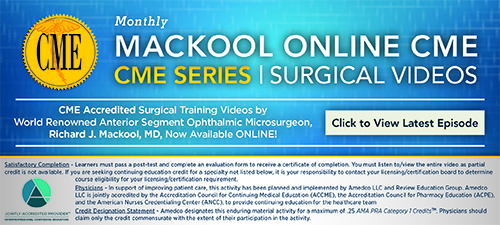| |
|
|
|
| Vol. 22, #3 • Monday, January 18, 2021 |
|
JANUARY IS GLAUCOMA AWARENESS MONTH
|
|
|
| |
|
Predicting Glaucoma Development with Longitudinal Deep Learning
Researchers assessed whether longitudinal changes in a deep learning algorithm’s predictions of retinal nerve fiber layer thickness based on fundus photographs could predict future development of glaucomatous visual field defects, as part of retrospective cohort study
This study included 1,072 eyes of 827 glaucoma-suspect patients with an average follow-up of 5.9 ±3.8 years. All eyes had normal standard automated perimetry (SAP) at baseline. Additional SAP and fundus photographs were acquired throughout follow-up. Conversion to glaucoma was defined as repeatable glaucomatous defects on SAP. An OCT-trained deep learning algorithm (Machine to Machine, M2M) was used to predict RNFL thicknesses from fundus photographs. Joint longitudinal survival models were used to assess whether baseline and longitudinal change in M2M’s RNFL thickness estimates could predict development of visual field defects.
Some of the results were:
• A total of 196 eyes (18 percent) converted to glaucoma during follow-up.
• The mean rate of change in M2M’s predicted RNFL thickness was -1.02 μm/y for converters and -0.67 μm/y for non-converters (p<0.001).
• Baseline and rate of change of predicted RNFL thickness were significantly predictive of conversion to glaucoma, with hazard ratios in the multivariable model of 1.56 per 10 μm lower at baseline (CI, 1.33 to 1.82; p<0.001) and 1.99 per 1 μm/y faster loss in thickness during follow-up (CI, 1.36 to 2.93; p<0.001).
Researchers wrote that longitudinal changes in a deep-learning algorithm’s assessment of RNFL thickness measurements, based on fundus photographs, were successfully used to predict risk of glaucoma conversion in eyes suspected of having the disease.
SOURCE: Lee T, Jammal AA, Mariottoni EB, et al. Predicting glaucoma development with longitudinal deep learning predictions from fundus photographs. Am J Ophthalmol 2020; Jan 7. Epub ahead of print.
|
|
|
|
|
| |
|
Ranibizumab for nAMD With or Without PCV: DRAGON Study
Investigators evaluated the efficacy and safety of monthly and pro re nata (PRN, guided by visual acuity stabilization and disease activity criteria) ranibizumab regimens in Chinese patients with neovascular age-related macular degeneration and polypoidal choroidal vasculopathy.
This double-masked study randomized nAMD patients (1:1) to ranibizumab monthly from baseline to month (M) 11 to a PRN regimen from M12 to M23 (monthly group, n=167) vs. ranibizumab, three monthly doses followed by a PRN regimen up to M23 (PRN group, n=166). Subgroups were assessed based on the presence/absence of PCV (indicated by indocyanine green angiography).
Of 334 randomized patients, 41.7 percent had PCV at baseline. Here were some of the findings:
• Mean average best-corrected visual acuity change from M3 to M4 through M12 was 3.3 letters with monthly, and 1.7 letters with PRN (mean difference: 1.6; CI: -2.95, -0.20, primary endpoint).
• Mean change in BCVA from baseline (monthly/PRN, 53.8/53.7) to M12 and M24 was 12.3 and 11.3 letters, respectively, in the monthly group; and 9.6 and 9.3 letters, respectively, in the PRN group.
• Corresponding values for patients with PCV/without PCV were 12.7/12.1 letters (M12) and 12.3/10.6 letters (M24) in the monthly group; and 9.4/9.4 letters (M12) and 9.7/8.7 letters (M24) in the PRN group.
• The mean number of injections was 11.4 (monthly) and 8.2 (PRN) from day 1 to M11 and 4.8 (monthly), and 5 (PRN) from M12 to M23.
• No new safety findings were reported.
Investigators wrote that the study results supported the use of ranibizumab monthly or PRN in Chinese patients with nAMD, regardless of presence of PCV.
SOURCE: Li X, Zhu Q, Egger A, et al. Two different treatment regimens of ranibizumab 0.5 mg for neovascular age-related macular degeneration with or without polypoidal choroidal vasculopathy in Chinese patients: Results from the Phase IV, randomized, DRAGON study. Acta Ophthalmol 2020; Dec 30. [Epub ahead of print].
|
|
|
|
|
|
|
| |
|
Endophthalmitis in Boston Type I Keratoprosthesis
Scientists determined the incidence and recurrence of Boston type I keratoprosthesis (KPro)-associated endophthalmitis, and its microbiological profile, risk factors and outcomes.
The retrospective study of 158 consecutive KPro procedures with a median follow-up of 78.4 months included medical charts that were reviewed for ocular history, contact lens and topical antibiotic use, visual acuity and complications. For eyes with endophthalmitis, time to infection, culture results and recurrences were collected. Scientists used Cox regression analyses to identify risk factors for endophthalmitis, and compared the risk for visual failure, KPro retention and globe loss between eyes with and without endophthalmitis.
Here were some of the findings:
• The incidence and recurrence rates of endophthalmitis were 1.7 percent and 6 percent per procedure-year, respectively.
• First episodes occurred at a median of 18.6 months.
• Eight of 18 episodes (44 percent) were culture positive, isolating mainly gram-positive bacteria (7 [88 percent]).
• Previous ocular burn (hazard ratio: 7.34; CI, 1.91 to 28.15); infectious keratitis (HR, 5.09; CI, 1.70 to 15.22); corneal melt (HR, 4.55; CI, 1.50 to 13.83); and postoperative contact lens wear (HR, 4.19; CI, 1.17 to 15.04) were risk factors.
• Eyes with endophthalmitis didn’t have a higher risk for visual failure (1.74, CI, 0.78 to 3.91) but were more likely to not retain the KPro (HR, 2.81; CI, 1.15 to 6.88) and undergo evisceration (HR, 2.81; CI, 1.15 to 6.88).
• All eyes lost ≥2 lines of vision during the endophthalmitis episode.
Scientists wrote that endophthalmitis is rare but vision and globe-threatening in eyes with KPro. They added that any associated corneal melts and infectious keratitis must be promptly treated, postoperative contact lenses should be considered on a case-by-case basis, and patients with ocular burns might require more aggressive antimicrobial prophylaxis.
SOURCE: Bostan C, Nayman T, Szigiato AA, et al. Endophthalmitis in eyes with the Boston type I keratoprosthesis: Incidence, recurrence, risk factors and outcomes. Cornea 2020; Dec 31. [Epub ahead of print].
|
|
|
|
|
| |
|
nAMD Treatment Burden Among Different Types of Neovascularization
Researchers evaluated differences in the treatment burden among different types of neovascular age-related macular degeneration.
This retrospective, observational study included 431 patients diagnosed with neovascular AMD. Patients were divided into three groups: type 1 or 2 neovascularization group (n=167); type 3 neovascularization group (n=50); and polypoidal choroidal vasculopathy (PCV) group (n=214). The number of hospital visits per year and the number of anti-vascular endothelial growth factor injections per year were compared among the groups. Furthermore, the incidence of bilateral involvement during follow-up was compared among the groups.
The mean follow-up period was 50.6 ±11.3 months. Here were some of the findings:
• The number of hospital visits per year was significantly higher in the type 1 or 2 neovascularization group (mean: 6.1 ±1.5) and type 3 neovascularization (6.6 ±1.6) than in the PCV group (6 ±1.5) (p<0.001).
• The number of anti-VEGF injections per year was significantly higher in type 3 neovascularization group (3.1 ± 1.7) than in the type 1 or 2 neovascularization group (2.3 ± 1.5) or the PCV group (2.3 ±1.2)(p=0.042).
• A significant difference was found in the incidence of bilateral involvement among patients in type 1 or 2 neovascularization group (20.4 percent); type 3 neovascularization group (46 percent); and the PCV group (15.4 percent) (p<0.001).
Researchers found that the high frequency of hospital visits and high number of anti-VEGF injections in patients with type 3 neovascularization suggested a high treatment burden in these patients. They added that the high incidence of bilateral involvement could be a primary reason for the greater treatment burden in patients with type 3 neovascularization.
SOURCE: Lee JH, Kim JH, Kim JW, et al. Difference in treatment burden of neovascular age-related macular degeneration among different types of neovascularization. Graefes Arch Clin Exp Ophthalmol 2020; Jan 6 [Epub ahead of print].
|
|
|
|
|
|
|
|
| |
Complimentary CME Education Videos
|
|
|
|
|
Industry News
Alcon Launches AcrySof IQ Vivity Non-diffractive EDOF IOL
Alcon commercially launched what it calls the first non-diffractive extended-depth-of-focus intraocular lens in the United States, the AcrySof IQ Vivity, a presbyopia-mitigating lens. Vivity uses a proprietary technology Alcon calls X-Wave, which the company says “stretches and shifts light without splitting it.” The IOL is also available in a toric version. Vivity received FDA approval in February 2020 and was made available to select U.S. ophthalmologists in September 2020 during a pilot phase, ahead of the national launch.
Read more.
Rezolute Initiates Phase I Study of RZ402 for DME Treatment
Rezolute announced the initiation of dosing in a Phase I first-in-human clinical study of RZ402, an investigational oral plasma kallikrein inhibitor, for the treatment of diabetic macular edema. The single-center, randomized, double-blind, placebo-controlled, single ascending dose study will evaluate the safety, tolerability and pharmacokinetics of RZ402 in healthy adult volunteers. Read more.
| |
Advertisement
|
|
|
|
Haag-Streit Introduces Lenstar Myopia
Haag-Streit introduced Lenstar Myopia, consisting of the Lenstar 900 optical biometer and EyeSuite Myopia software, developed in close cooperation with myopia experts Thomas Aller, OD, and Pascal Blaser, founder and developer of myopia.care. Aside from axial length measurements, the company says Lenstar 900 offers a wide range of data including keratometry metrics for making accurate predictions about myopia’s onset and progression. Read more.
|
|
|
|
|
|
| |
Review of Ophthalmology® Online is published by the Review Group, a Division of Jobson Medical Information LLC (JMI), 19 Campus Boulevard, Newtown Square, PA 19073.
To subscribe to other JMI newsletters or to manage your subscription, click here.
To change your email address, reply to this email. Write "change of address" in the subject line. Make sure to provide us with your old and new address.
To ensure delivery, please be sure to add reviewophth@jobsonmail.com to your address book or safe senders list.
Click here if you do not want to receive future emails from Review of Ophthalmology Online.
Advertising: For information on advertising in this e-mail newsletter or other creative advertising opportunities with Review of Ophthalmology, please contact sales managers Michael Hoster, Michele Barrett or Jonathan Dardine.
News: To submit news or contact the editor, send an e-mail, or FAX your news to 610.492.1049
|
|
|
|
|
|
|
|